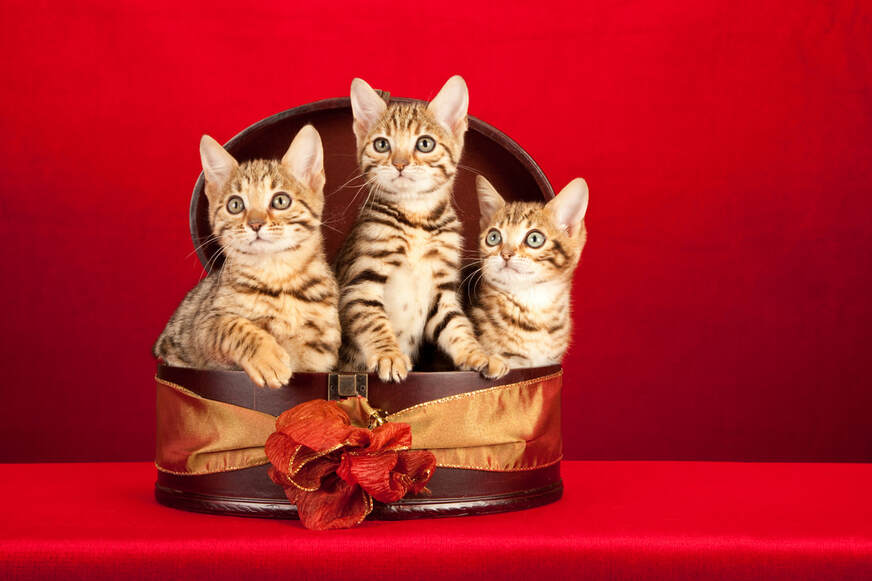 At Registered Bengals We feel strongly that choosing your Bengal breeder is a serious decision and that Bengal kitten buyers should be well informed. We are a Bengal Cattery (Bengaltime TICA & CFA) Located just North of Portland, Oregon in Kalama, Washington. We specialize in Brown Rosetted, TICA Registered, Purebred Bengal kittens. Our kittens are lovingly hand raised with no cages and freely roam our home like members of our family. Our cats are not “wild”, however, they are very active, love attention and love heights. Our kittens gets lots of individual play time and are constantly exposed to our family and other feline family members, so they are used to interacting with people and other cats. Choosing a Bengal breeder is a serious decision so it's important that Bengal kitten buyers be well informed. Knowledge Every Breeder should have a good knowledge of the history of the Breed, importance of genetic screenings, about Breed temperament and social characteristics. Understanding the history of the breed allows a you and the breeder to understand where the Bengal Breed is getting it's characteristics and also which genetic screenings to use to increase the overall health of the Breeder's lines and the Breed itself. (See Also Bengal Health) Breeding without genetic screenings is what keeps harmful genetics in the bloodlines. Where did the breeder get their Breeding Bengals from? Fresh Bengal lines should be pulled from locations not adjacent to the breeders location. Breeders that are only out for a profit won't care who they sell to. Responsible Breeders try to be sure that a Bengal kitten is a good fit for the buyer. (See also Is a Bengal Kitten right for you.) Motivation: It's important to determine what the motivation is behind why a Breeder is choosing to be a Bengal Breeder. Some questions you should ask yourself are: Is the breeder taking shortcuts to obtain more profit by using cheap or inferior food, is the Breeder knowledgeable about the history of the Breed and specific health concerns to avoid, what are the goals the Breeder has for their Breeding program? The reason why motivation is so important is that if profit is the bottom line, then short-cuts will likely lead to kittens whose health and temperament can be questionable. Environment and Socialization - See also Bengal Buyers Checklist It's important to understand how the Breeder is keeping the kittens you are buying and also how is the Breeder treating the Breeding Bengals themselves. You don't want to unwittingly encourage kitty mills, sacrificing the lifestyle of the Breeding Bengals just for an "economical" kitten. This information also goes back into what is the motivation behind Breeding. You should ask if there is a "Socialization Program" in place to insure that every kitten being produced is going to have that famous Bengal social temperament. Remember, a Breeder that has a smaller operation won't necessarily produce a better socialized kitten because of the perception of more intense care than another Breeder with a larger operation as long as there is a good Socialization Program in place! We highly encourage you to visit the environment of the Cattery in person if you can and question the Breeder on their Socialization Program. This is more important for Bengals specifically because they are bred to be very social and absolutely require stimulation and if this fact is being ignored by the Breeder, than you should be prepared to re-socialize your kitten! You should also consider your available time. Most reputable breeders will ask you how much time you have to spend with your new kitten and whether you have children or other pets in the home. WHY? Because Bengals require a lot of stimulation and if you're not able to provide that, most breeders will recommend that you buy two kittens at the same time to insure your new kitten has a play partner to keep him or her occupied when you are not home. This will prevent MANY behavioral issues in the future. See Also Why Two kittens are better than one Breeder Commitment Has the breeder committed to ethical breeder standards in TICA, CFA or other Bengal organizations? How active is the Breeder in the Bengal community? Can you find the Breeder online in the TICA organization, CFA the FaceBook community, youtube, ect? An active involvement in the Bengal community shows that there is a passion for the Bengal Breed and that they're interested in sharing and learning from other Breeders. Does the Breeder have a Reputable Breeder status in any organization? This would show they take the time to let everyone know how dedicated they are to the Breed as this distinction requires higher standards and hoops to jump through and is not achieved easily. Another good sign of Reputation is how quickly are they getting their kittens homes. If you have a Breeder that is trying to sell older kittens verses a Breeder that has a wait list of people clamoring for their kittens, then you have to ask yourself what is the difference everyone else is seeing? Sometimes going with a Breeder simply because you can get your kitten faster as opposed to waiting for a quality kitten from a Breeder with a well-known reputation can have unforeseen consequences later. There may be a reason your kitten was available so quickly that you are not aware of. Quality People buy Bengals for many different reasons. Some do so for the hypoallergenic nature they have, while others like the dog-like personality they are known for, but more do so for the exotic wild appearance that garners attention everywhere. This is called the "WOW factor." In the show ring, titles are won by how closely a Bengal will adhere to a strict standard that was determined by TICA or CFA. In the rest of the world, quality is determined by the glittered plush pelts that show stark contrast and bold colors that scream EXOTIC. Simply put, not all Bengals are created equal and if you have a Breeder that has taken the time and invested savings into purchasing Breeding Bengals that are high quality, then the kittens produced will likely carry the same high quality. Quality can also be seen in terms of health, which should be obvious if the Breeder practices genetic/vet screenings. Breeders who mention personalities of their Breeding Bengals on the respective Queens and Studs web pages are obviously showing they understand the importance of temperament. Cost Sometimes it seems simpler to choose a Breeder on what seems to be the more "economical" price. However, the phrase you get what you pay for will almost certainly hold true. This does not necessarily mean that Breeders that charge more are giving a better quality kitten for the price. The best means of deciding if you are in fact getting what you are paying for is to take the entire picture into consideration. Simply put determine what exactly are you being offered in exchange for your hard-earned money? There are many things that go into the price of Bengal kittens
Time Consuming Factors good Breeders must consider are:
If the Breeder you are considering is NOT spending the money they are making on all of these factors OR spending their time with everything that's needed to Responsibly Breed, Then the Breeder is taking shortcuts and you are spending too much! Kitten Prices should be based upon how much a Breeder is investing into their Breeding program and how much of their time they are using to breed responsibly. Recap You are spending a considerable amount of money but more importantly, you are putting your time and heart into a companion that will be with you for many years. With this kind of investment, it's important that you take the time to research and choose the best TICA Registered Purebred Bengal Breeder to ensure that you are getting what you are paying for in terms of quality, health, and temperament. You should ask serious questions to determine the Breeder's knowledge, socialization program, breeding goals and to determine if the cost is representative of what the breeder is offering. A reminder that there are MANY Bengal scams online and just a short search will show 50% off Bengals. Proceed with extreme caution with these as virtually every single one is a scam and you will either not get your kitten at all or will not get a purebred registered Bengal kitten. Almost all cut price sellers are selling kittens that can not be registered as Bengals, are of very low quality, have genetic or other diseases that will dramatically shorten their lives... If it sounds to good to be true, it probably is... We encourage you to visit our site and get on our list for kitten updates. (https://registeredbengals.com/kittens1.html) Also take a look at the Bengal related links and products on our products page. (https://registeredbengals.com/products.html) "If it's not a Bengal, It's just a cat"
0 Comments
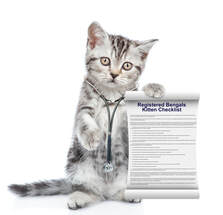 Purchasing a Bengal kitten is one of the best things you’ll ever do, but it’s also a big responsibility. Be sure to consider carefully before taking on the challenge that these amazing bundles of joy bring. Before you buy see the articles at the links below. Is a Bengal Kitten right for you Things you should know before getting a Bengal Bengal Cat information Now that you have carefully considered the items above and made the decision to buy a Bengal, We will walk you through the basics of how to take care of that playful, purring bundle of energy. Bengal kittens are so cute, it’s understandable that Bengal owners wish their kittens could stay kittens forever. This is the critical time when you, as the pet parent, lay the foundation for your cat’s future health and behavior. It’s also the stage where you have to decide what food to buy, what vet to visit, where to place the food dishes and litter box. The good news is that all of your hard work during these first few months will be rewarded by years of love and enjoyment. The first months are critical: Your kitten will arrive from the breeder at approximately 10 to 12 weeks of age. Kittens have very specific developmental needs for the first 10 weeks of their lives in terms of nourishment, warmth, socialization, and socialization. For this reason, most breeders typically wait until their kittens are at least 10 weeks old before they’re put up for Sale. If you, by chance, find yourself in a situation where you need to care for an orphaned kitten under 10 weeks old, consult your vet for special instructions. Find a Good Vet: This Link May Help If you don’t have a vet in mind already, ask friends or the breeder that you got the kitten from for recommendations. Local dog walkers and groomers are also a great resource for Vet recommendations. One of the first things you should do with your new kitten, if not the very first, is take him in for an exam. This trip is almost as important for the owner as it is the kitten, because it not only tests for health issues like birth defects, parasites, and feline leukemia, but it allows you to ask those all important questions including advice on litter box training your kitten. Please note that reputable breeders test all breeding studs and Queens for Genetic defects. See Bengal Buyers Checklist Get the Most Out of Your First Vet Visit: See also Bengal Cat Vet Visits
Shop for Quality Food: Feeding a kitten isn’t as easy as grabbing a bag of cat chow at the nearest convenience store. Growing kittens need as much as three times more calories and nutrients than adult cats. That’s why it’s important to find a good quality food designed especially for kittens. There are many in the Bengal community that believe Bengals in particular should be fed a Raw Diet. You will need to weigh you options, consult your Vet and make a decision. A name brand food, formulated for kittens, is the simplest way to ensure that your kitty gets the proper nourishment without supplements. Here at Bengaltime Cattery we feed a mixture of Raw, Canned and Royal Canine Dry Kibble, served separately in the morning and evening. We leave food out all day for our Breeding Queens and Young Kittens. Set Up a Feeding Schedule: To keep up with your kitten’s appetite, you’ll want to establish a daily feeding routine. The best way to ensure that you’re not under or over-feeding your kitten is to consult with you veterinarian about how much and how often to feed. At 3 to 6 months of age, most vets recommend feeding your kitten three times a day. Once he’s reached six months, you can scale it back to twice a day. Keep stocking your pantry with kitten food until your baby reaches adulthood, 9 to 12 months old. In addition, don’t forget to keep his water bowl fresh and filled at all times. But hold the milk. Contrary to popular belief, milk is not nutritionally sufficient for kittens and can give them diarrhea. Your kitten should arrive from the breeder already litter box trained. Prepare a Room: See Also Bringing your new kitten home Before you bring your kitten home, it’s best to designate a quiet area where the kitten can feel comfortable and safe. In this base camp, you’ll need to put a few essentials like food and water dishes, a litter box (preferably one with low sides), and some comfortable bedding. Tip: Remember, cats don’t like their food and litter box too close together. So place the food dishes as far away from the litter as possible within the space. Spend time with your kitten: See Before your Kitten Arrives and When you get home. Once your vet has cleared your kitten as free of disease and parasites, it should be placed in a small room with it's litter box and food to settle down and get comfortable with it's new surroundings. A Bedroom is ideal. BUT remember that the room you start with will be your kittens go to room for safety for a long time to come. We suggest that you allow your new kitten to acclimate in the safety of this smaller area for two weeks before allowing the full run of the house. This allows the kitten to bond to you and get comfortable in it's new surroundings. Now after your kitten is comfortable with you and it's new surroundings, it’s safe to let your kitten explore the rest of the house and other pet roommates. Handling and playing with your kitten at least two or three times a day will help him or her form a strong emotional bond with you. If you have children, monitor their introduction to the new kitten to make sure it’s a positive experience for both the kitten and child. Get Ready: We have put together a list of our recommended Bengal products at this link. Here’s a list of some of the important items you’ll want to have before bringing your kitten home:
Watch for Early Signs of Illness: See Also Bengal Health Relocating and being taken from it's mother and litter mates is stressful and young kittens are more susceptible to a number of illnesses, it’s always best to catch a health issue in its early stages. Contact your vet immediately if your kitten displays any of the following symptoms.
For Bengal kitten updates and information visit and like us on Facebook too. For more Bengal related content and information or to find your purrfect Bengal kitten or Bengal Related Products, visit us at RegisteredBengals.com
See also, Things you should know before getting a Bengal. "If it's not a Bengal, It's just a cat" If you have one, You know it's true...  Are you aware of and up to the responsibilities of being a Bengal owner? Bengal cats are becoming more and more popular among cat fanciers and for good reason. Bengals offer the best characteristics of cats with a few dog traits thrown in. The Bengal is one of the most exotic breeds of cat that you will ever come across. The uniqueness of their breed lies within their blended bloodlines giving you an animal like no other. The Bengal cat is a cross between a domestic cat and an Asian leopard cat. The blend of these two bloodlines created a mix that is hard to match in any other breed of cat. Are you ready to bring a high energy kitten into your home?
Bengal Cat Traits: Size: The average size of Adult Bengals is about the same as most other cat breeds with adult males weighing slightly more than adult females. In general an adult Bengal will weigh between 10 and 14 pounds. Life Span: When fed properly and kept up to date with vet checks and activity levels, you can expect your Bengal cat to live a long and happy life of 15 to 18 years or more. Shedding / Hypoallergenic: Because they have a more dense Pelt versus a normal cats fur the bengal cat sheds very little in comparison to other cat breeds. In addition Bengals are one of just a few cat breeds that are Hypoallergenic. Meaning they are less likely to cause an allergic reaction in people who are allergic to cats. Coat Colors and Patterns: Bengals come in a variety of coat colors and patterns and you can find an excellent resource at this link on most of them. In general the most popular color is the brown Rosetted. Bengals come in shades of brown, silver, charcoal and a few colors in between with a few different patterns. Everyone has their own favorite look but in general the wild tiger look is what draws people to this breed. Bengal Health: Like a domestic cat, Bengals have health issues and some genetic issues that you should be aware of. There is a detailed list of these issues at this link, Reputable breeders will screen for these issues in their breeding program to insure that you get a healthy, happy, well socialized companion that will live a long and healthy life. To promote the Bengals health, we must provide him or her with an optimal environment for their development. Whether they are a pet or a breeder in a breeding program, all Bengals have the same needs:
Cost:
Outdoor or Indoor Cat?
Taking walks outside on a harness is excellent stimulation as well as exercise. Starting young with a well fit harness goes a long way to enhance your fun and relationship with your Bengal cat. It does take a little work to get them used to the harness but it's worth the effort. Be aware though that once your Bengal has been outside with you, they will want to be outside all if the time. SO don't take them out if you don't plan to do it often... See Should your Bengal be allowed outside? What will you feed your cat?
Does the Bengal breed fit your lifestyle?
Bengal Cat Personality: Because of their recent connections to the Asian Leopard Cat, Bengals have personalities that are different from most cat breeds and some people say Bengals are more like a dog than a cat. Bengals seem to be more easily trained and many prefer the company of humans as would a dog. Bengals are lively, intelligent and interactive cats. They, typically, don’t ignore you nor are they dull cats. They will be an active part of your family. They are outstanding athletes: running, climbing and jumping to huge heights. They’ve been known to play fetch and can be trained. Most Bengals love attention too and will frequently nuzzle your face, flip on their backs and crave affection. Don’t be surprised to see your Bengal jump on the bed and kneed the covers with their paws and sleep with you until morning. Bengals are not wild animals. Unless you specifically buy an early generation Bengal, then your Bengal will be many generations removed from the Asian Leopard Cat and they have been domesticated with lots of skill and work from dedicated Bengal breeders. They will be no more aggressive or wild than any other domestic cat. When properly socialized Bengals will get along with other house pets and can be part of a multi pet household. The key is in the introductions to others as a kitten, this is one of the BIG reasons that it is important to find Bengal kitten breeders that spend the time with their kittens to socialize them. Bengals and Children: Just as in humans, every Bengal is different but in general Bengals are good with other members of the family and children. This again goes back to how the breeder socialized the kittens. If the breeder says the kittens are shy, it is a sure sign that they have not spent enough time interacting with them. If possible visit the breeder and spend time with the kitten before you buy one. Pick the one that seems to be the least shy and wants your company or wants to play. Ease of training: Unlike other cat breeds, Bengals are able and willing in most cases to be trained and are willing to accept commands from their owners. Bengals can be trained to walk on a leash which is VERY rare in the cat world. Prepare for a few strange looks... Because of the popularity of Bengal cats you should NEVER allow your Bengal to go outside without you. It is likely to end up as someone else's pet. Most Registered Bengal Breeders will have a microchip implanted in the kitten. It is about the size of a grain of rice and can easily be scanned by vets during visits or by animal control if they were to find your cat so that it can be returned to the proper owner Biting: Bengals do not bite any more or less than any other cat breed and in general will only bite if they are in danger. Playful nips during play are common and rarely do any harm. Vocalization: Bengals tend to speak more than many other cat breeds and will let you know if they need or want something. Intelligence: Bengal cats are one of the most intelligent of the cat breeds, Knowing this it is easy to understand why they are more vocal than most other breeds. If they are vocalizing they are in many cases trying to communicate with you or let you know they are displeased about something Affection: Bengal cats love to cuddle and will show their owners affection. They will bond with their owners and show lots of love. BUT if you try to force a bengal to cuddle you are likely to get a hiss or even possibly a scratch. You can't force love... Every Bengal will be different in the amount of handling and cuddling that they want and need. Kids: Great! Bengals love kids and enjoy their high levels of energy. All of our Bengals have been socialized with some very energetic, grabby and loud children so they will be familiar with most behaviours that children do. Just remember that children need to be coached on how to approach a kitten and how to be gentle. Dogs: Great! With all other pets make sure that they are gradually introduced and have an opportunity to get familiar with each other’s scents before they physically meet. Bengals can actually bond with dogs and become great friends. Water play: Some Bengals especially love to get in the shower or play in the tub. A fountain with running water such as commercially available cat drinking fountains can provide a lot of fun for your Bengal . Sometimes they may take a toy and drop it in the water as if to see if it is playing dead. Or they may take a paw and dig beside the fountain as though they are digging up water… It's all lots of fun to watch! You wouldn’t believe that a cat could like water so much. Most Bengals love to splash and play with water. Running water from a sink or a fountain is a blast to play with. Watch your toilet (especially if you use cleaning agents like bleach) and running hot water. It’s rare, but some Bengals have also been known to swim or to shower with their owners! Summary: When purchased from the right breeder and properly socialized as kittens, Bengals make excellent pets and companions. The key is finding the right breeder. Shop carefully and use the checklist provided at this link as a guide in making your decision. (Breeder Checklist). For more Bengal related content and information or to find your purrfect Bengal kitten or Bengal Related Products, visit us at RegisteredBengals.com See also, Things you should know before getting a Bengal. "If it's not a Bengal, It's just a cat" If you have one, You know it's true...  Cats are obligate carnivores. They are intended to eat a diet of birds, Lizards and small mammals and the structure of their teeth and jaws tells the tale. All of the teeth, not just the incisors and canines, or cat-nines as they are called, are pointy. The molars, which are flat for grinding food in herbivores and omnivores, are even sharp and pointy in cats. Also, the jaw has no ability for side to side grinding motions. In nature, when a cat, whether domestic or Bengal eats prey, the function of the teeth and jaws is to tear the prey into bite sized pieces that are then swallowed. In this process, the muscle tissue, connective tissue, fur and feathers slides between the teeth, essentially cleaning and flossing the teeth as the cat consumes the meal which is, very low in carbohydrates. Dry cat food does not keep a cat’s teeth clean. Many times, when a Veterinarian opens the mouth of a cat during routine examination they find a mouth full of gingivitis, tartar, lesions and exposed sensitive areas of the teeth. (See "Feeding your Bengal a Raw Diet) Dental disease can also affect a cat’s overall health: Infections and inflammation resulting from dental infections can cause inflammation in the blood vessels. These blood vessels fan out into fine little networks in internal organs such as the kidneys. The inflammation in these blood vessels can contribute to kidney disease as your cat ages. Syndromes such as Type 2 Diabetes can also be impossible to resolve until the diseased teeth are removed from the mouth. Many times cat owners say after diseased teeth have been extracted from their cat that they didn’t realize how much trouble the diseased teeth were causing until after they were removed, and they got their “old” cat back who was once again playful, responsive, and doing old habits and routines. Sometimes seemingly unrelated skin infections resolved as well. Diseased teeth place a burden on the cats the immune system. Many times the cat owner says , I feed dry / kibble diet!. How could this be? Dry Kibble does not clean a cat’s teeth, and it is high in carbohydrates as well. Canned diets do not clean the cat’s teeth either, nor does mush raw diet, but at least these it is low in carbohydrates. There are ways to help your cat’s teeth. (See "Feeding your Bengal a Raw Diet) If your cat will tear at a piece of meat on a regular basis this can help. The gold standard is for you to brush your cat’s teeth. But please reserve judgement until after you look at the dental video produced by Cornell University. It outlines steps to help your cat find tooth brushing acceptable or even a good thing. Regular tooth brushing can greatly impact your cat’s oral health and overall health. Regular brushing can also increase the time between necessary scaling and polishing and prevent the need for surgical tooth extractions. Dental scaling and polishing is still important to your cats overall health. Scaling and polishing removes the plaque buildup on the tooth surface and with high quality dental instruments, below the gum line. Eighty Percent of dental disease begins below the gumline. You can't see this though there may be a clue in the form of gingivitis or a red line along the gumline. Proper diet can lengthen the interval between necessary scaling and polishing. And the closer the diet replicates the diet found in nature, the less dental care your Bengal will need. Many breeders and pet owners report healthier, happier cats as a result of proper Raw feeding. Cats are not built for a dry kibble diet. For more Bengal information and resources visit us at this link. "If it's not a Bengal, It's just a cat" 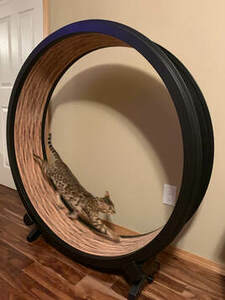 Some of the main differences between a Bengal and a domestic cat is their energy level, curiosity and need for stimulation. Bengals love to run and play and especially to climb up high. A tall scratching post especially with perches at the top is a very good addition to a home with a Bengal . There are also wall shelves and climbing toys, many of which are available on Amazon. A cat wheel such as the one made by one fast cat will help your Bengal get most of the exercise that they need. With very little training they usually take right to it! It's so much fun to watch them walking and running full speed on the wheel. We find the exercise wheel made by one fast cat to be a nice quiet wheel relative to others we have purchased and it literally took less than Ten minutes of play with our Bengal Girls to get them up and running. From there it is just a matter of any new Kitten or cat watching others play and on and on it goes with no further training required in many cases. Toys: Feather toys or wand string feather toy combinations are great for Bengals. With the flick of your wrist you can give your kitty a lot of exercise! Cats prefer many short episodes of play a day, but a Bengal can go for quite a while! Two Kittens: The absolute best way to insure that your Bengal kitten or cat gets the exercise that they want and need is to get them in Pairs, We have an entire article on why this is a good idea. at this link but in short getting two kittens or cats at the same time and especially related pairs that have grown up together solves many issues and especially gives your new kittys endless hours of play and exercise time as they play together, jump on each other and more. If you have ever bought two cats from the same litter at the same time, you know exactly what I'm talking about. Of course getting two kittens may not be the right choice for everyone. Water play: Some Bengals especially love to get in the shower or play in the tub. A fountain with running water such as commercially available cat drinking fountains can provide a lot of fun for your Bengal . Sometimes they may take a toy and drop it in the water as if to see if it is playing dead. Or they may take a paw and dig beside the fountain as though they are digging up water… It's all lots of fun to watch! Taking walks outside on a harness is excellent stimulation as well as exercise. Starting young with a well fit harness goes a long way to enhance your fun and relationship with your Bengal cat. It does take a little work to get them used to the harness but it's worth the effort. To summarize if you want to avoid a fat cat or one that looks for ways to get into trouble to burn off excess energy it's time well spent to find a way for your Bengal to get the exercise that it wants and needs. For more bengal related news and information visit us at RegisteredBengals.com "If it's not a Bengal, It's just a cat"  Should Bengals Go Outdoors? Whether Bengals should be allowed to go outdoors is a tough topic which has many thoughts on both sides. It’s a decision that everyone has to make, not just Bengal owners however, there are a few additional factors for Bengal owners that don’t apply to most other cats. So let’s explore the thoughts on both sides of the topic. Why you shouldn’t let your Bengal outdoors: The average life expectancy of an outdoor cat is significantly shorter than an indoor only cat – by over 10 years. In an urban/suburban area, you are reducing their expected life by over 50%! Here are some things that can happen to a Bengal who roams outdoors:
Reasons to let your Bengal outdoors:
Outdoor Solutions: So what do you do if you want to let your cat go outdoors but don’t want to stress over all the cons?
For more information and Bengal Resources, visit our site - Registered Bengals
"If it's not a Bengal, It's just a cat." 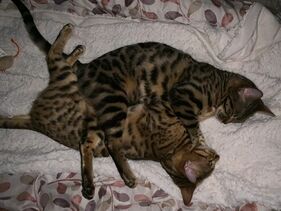 It's best when kittens go in pairs. Yes, think two instead of one if possible. So you have made a decision to buy a Bengal kitten! Choosing the right kitten is a big step, but it's worth it and the results are very rewarding. If you’re thinking about bringing a kitten into your life, there are many reasons why you should actually consider doubling that and bringing home a pair. Starting off with two may actually be much easier and more beneficial for the kittens and for you. Our experience is that kittens adapt and settle in much better as pairs or into a home that already has another young kitten. If you have decided to buy a Bengal, it's worth considering getting two if you don't already have a young cat in your household. This can be less work for you, because the kittens will expend much of their youthful energy on each other. The companionship will make for more well-adjusted pets and you will almost immediately understand why getting two was the right decision as you watch their interactions. Two kittens are easier to care for. Here are a few reasons:
Of course it depends on the established cat’s personality, but in our experience, we find that many adult cats’ patience can run thin when a kitten wants to play. Though it might sound contrary, an older, established cat will probably accept two kittens better than one. One kitten will seek out the older cat as a playmate, or worse, tease and pester the senior cat which can cause stress to an older cat. The kitten in return, will be “rewarded” for his playful efforts with hisses and swats. Two kittens will expend their energy in play with each other, leaving their older “uncle” to relax in peace. Kittens and Life Enrichment: For a kitten, the ability to have a companion for playtime can be one of the best forms of enrichment. Let’s face it, you have to work and spend time away from home and a little kitten can get lonely and even scared. Many people are under the false impression that cats are solitary and don’t want companionship but they do have a social structure and most truly benefit and thrive when they have a feline buddy. The companionship two kittens can provide each other may help prevent future behavior problems from boredom or separation anxiety. Often, the bond between two cats who have grown up together becomes very strong and special. Watching two long-time cat companions curled up together as they nap in the afternoon sun is a precious sight. Cost and Care of Kittens: After the initial kitten vaccinations, the veterinary costs taper off in most cases. You’ll most likely just be dealing with routine yearly appointments. Many veterinary clinics offer multi-pet discounts as well so be sure and check that out to save even more money. When it comes to toys and cat furniture, your biggest expense will be a cat tree (I highly recommend that you get one or more) and you’d have that expense regardless of whether you purchased one kitten or two. And if you’re at all familiar with cats, you know that some of the best cat furniture are empty cardboard boxes. You can make a cat condo by using duct tape to connect several cardboard boxes. Cut holes in the boxes and create a fun kitty playground. Simple and very inexpensive. When it comes to care, such as grooming, trimming nails, and so on, if you start training them to accept the process while they’re young, then the process will be very quick once they become adults. Train your kittens to enjoy being touched and handled and it’ll make life much easier down the road should you ever have to administer medication when they’re older. It’ll also enable you to do nail trims at home. The key is to start the training early, be consistent and be gentle. Make it a quick, fun experience that ends with a treat or other reward. Spay / Neuter: If the kittens were not sold to you spayed or neutered You have to remember to get them spayed/neutered before they become sexually active, even though they are likely to remain indoor cats, because cats become sexually mature between 5 and 8 months of age. Because of this, cats are usually spayed or neutered between 4-6 months, although it can be done as young as 12 weeks of age. We DO NOT recommend Early Spaying or Neutering. Failure to spay or neuter in time causes a host of issues but the worst is marking and spraying which after it has started is very difficult to stop. To Summarize: Getting two kittens together means that they can play together, learn from each other, and keep each other company. In general terms, it seems like the answer to the question, “Should I get one kitten, or Two?” Is Two kittens are always better than one. Need More Information? If you’re new to the world of Bengal kittens, here’s our New Kitten Buyer checklist and FAQ "If it's not a Bengal, It's just a cat" Registeredbengals.com 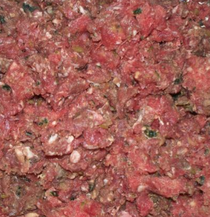 Are Raw food diets good for Bengals? Everyone knows that proper nutrition is essential to a cat's well-being. Choosing the right food can be hard, especially when we have to worry about the ingredients in commercial pet foods and pet food recalls. Some owners choose to feed their cats home-prepared diets, so they know exactly what is in the cat food. Other owners choose a Raw diet. What Is a Raw Diet for Bengals? Feeding cats a Raw diet means feeding them uncooked animal muscle meat, organ meat, and bones. This type of food is sometimes called the BARF diet, which stands for "bones and raw food" or " biologically-appropriate raw food." The ideal Raw diet is prepared based on a carefully designed recipe. Many cat owners choose to prepare these diets themselves, but commercial forms are also available. If you choose to feed your cat a raw diet, it should be one that has been determined complete and balanced. A biologically appropriate raw diet is the closest thing to what your cat’s ancestors would have eaten in the wild. By feeding your cat the way nature intended, you fuel a happy, healthy, vibrant lifestyle for years to come. Why Consider feeding a Raw diet? Bengals are obligate carnivores. In short, this means they must eat meat to survive. Cats do not actually need vegetables and carbohydrates in their diets. In fact, they can only tolerate carbohydrates in small amounts. Instead, cats thrive on high-protein, high-moisture diets rich in substances only found in meat. This includes amino acids like taurine, fatty acids, and other essential vitamins and minerals. Supporters of Raw food diets believe that cooking meat alters or decreases these vital substances. They advocate for a biologically-appropriate diet that closely mimics what a cat would eat in the wild. In general, small wild cats hunt and eat rodents and other small mammals, birds, fish, insects, and even reptiles. When it comes to feeding your own cat raw food, the idea is to create a diet that is similar. There is some controversy revolving around raw food diets for pets. Those who support raw food diets have much to say about the health benefits:
While these claims tend to ring true, the opposition has valid concerns about the safety of Raw food diets. Are Raw Food Diets Safe? It is important to know that feeding raw food to your cat comes with some risks. Raw food may contain pathogens like Salmonella and E. coli that can lead to serious life-threatening infections. Cooking food removes most of these pathogens, which is why we humans cook our food. Cats can digest raw foods better than humans, because they have shorter, more acidic digestive tracts. Many pathogens will pass through a cat without causing any issues. However, not all cats can tolerate raw food. Perhaps the greatest risk of feeding and handling raw meat comes down to cross-contamination. Feeding your cat a raw food diet can expose you and other people in your home to dangerous pathogens. Pathogens can remain on preparation surfaces, food dishes, in cat fecal matter and even on your cat (especially around the face). Raw diets should not be fed to cats living in homes with immune-compromised individuals. They should also be avoided in households with young children and/or elderly people. While it's impossible to eliminate all risk, there are some ways to try to be safer when feeding a raw food diet to your cat:
Bones are a safety concern when it comes to Raw food diets. Small whole bones or pieces of bones can cause complications such as gastrointestinal obstructions, oral injuries, and airway obstructions. If animal bones are included in your cat's Raw food diet, they should be ground up thoroughly. Complete and Balanced Raw Food Diets: One of the biggest mistakes owners make with Raw food diets is not making sure the diet is complete and balanced. Some people just feed "all meat and bones" or a wide variety of meats without actually paying attention to the calorie, fat, protein, and nutrient content. Don't assume your cat is getting everything needed for good health by simply feeding "as much meat as desired." Over time, an incomplete diet can lead to serious health problems for your cat. When developing your cat's raw diet, consult with your veterinarian about recipes that offer complete and balanced nutrition for your cat. Know that many vets will not recommend raw diets due to the risks involved. If you feel strongly about trying a raw diet and your vet is not flexible at all about raw diets, seek out a veterinarian who is experienced with raw diets. Better yet, find a veterinary nutritionist. It is essential that you find an expert to help you develop a complete and balanced diet that will truly benefit your cat. Your vet may also recommend special supplements to ensure your cat gets the nutrients needed to stay healthy. Ingredients used in a raw food diet may include the following:
You will need the following equipment to prepare the raw diet: If you choose to prepare your Raw diet yourself, you will need the items below.
Preparing a Raw diet at home can be a bit time-consuming, so most owners prefer to make enough to last several weeks and keep it frozen. If you are not able to take the time to develop recipes and prepare raw food at home, you may wish to try one of the many commercial Raw diets available. Raw diet supporters often consider commercial raw diets inferior to those prepared at home. However, they are healthier than feeding kibble. Commercial Raw diets are usually frozen or freeze-dried to minimize pathogens. Remember that safe-handling precautions should still be taken with these diets to prevent cross-contamination. Ask your veterinarian or veterinary nutritionist for help finding the right commercial diet. Make sure it is complete and balanced. Summary: Bengals need a diet composed primarily of meat. Switching to a Raw cat food can greatly improve your cat’s health by avoiding many of the problems associated with poor nutrition such as hydration imbalances, kidney disease and crystals and urinary tract infections. Cats are obligate carnivores, meaning they have nutritional requirements that can only be met with a diet based almost entirely on animal tissue. Their bodies don’t produce the enzymes required to digest carbohydrates. When you switch to a Raw Food you’ll notice:
How much Raw should be fed: The general rule of thumb for the amount to feed adult cats, either in Raw food or canned food, is to feed 2 to 4% of the cat's ideal body weight per day. For an inactive and/or older cat the 2% amount might be good and for a very active and/or younger cat, 4% might be closer to what's needed. For more Bengal Raw feeding information and resources please consider these vendors: Hare today for your Raw Diet - Hare-today.com Nu-Vet plus for supplements Nuvet.com Registered Bengals - Products Page - For other Bengal related products and resources.  FUN BENGAL FACTS! There are a lot of amazing facts about Bengals, but the ones below are some of the best. Wild Ancestry Bengals have links to real wild cats since they are the result of a cross between domestic cats and the Asian leopard. so a little wild behavior from these cats won’t come as a surprise to you if you are looking to adopt one of them. Bengals can Befriend Dogs: Often times, we use cats and dogs to refer to mortal enemies or to a severe downpour, but not this time. The Bengal cat has somehow learned to win dogs’ hearts. In fact, they – just like humans – could become a dog’s best friend. To make this friendship work most efficiently, the owner is advised to introduce a dog to the home when the Bengal is very young or vice versa. This way, they grow together, watch out for each other and become dependable members of your entertainment team. In some way Bengals are more like dogs than cats. If you own one you almost certainly see this. Bengals Love Water: Very clearly, this is another quality they share with tigers; their much distant relatives. You may also wonder why a cat should want to get in water but it is true. They play with water at every opportunity they get. Often times, you find them licking water from their paws rather than dipping their heads into a bowl and lapping water from there. Their love for water, combined with their dexterity at fishing, make them a potential threat to your aquarium if you have one in your home. Turn on a tap and your bengal is likely to be there checking it out. Bengals Know Just How to Steal: Call it kleptomania or anything you want to call it, but Bengals love to “borrow” items that catch their fancy. When I say borrow, I am trying to be polite with words because in reality, they don’t return the things they borrow. So watch out for that beautiful tablecloth on the table. Its secret admirer may have some use for it if you don’t mind. Bengals are Great Hunters: Cats are famed worldwide for their impeccable ability to hunt down small snakes, rats and other lower reptiles such as lizards. Their rivalry with birds is also renowned but it seems the Bengal cat has taken this avian rivalry to a whole new level. Once they sight a bird, they become automatically excited and will do anything within their power to play with these birds. Most times, or even at all times, this play is never one that favors the birds. If you have an avian pet; you should provide extra security for them because your dear feline pet will come for them. Bengals are Excellent Climbers If you wouldn’t mind enjoying your cat do some acrobatic displays once in awhile – and who wouldn’t love cat acrobatics – you will find the Bengal cat much fun in your house. They seemingly unlimited energy and the agility of monkeys. You can count on them to climb to heights you never expected them to reach, as well as expect them to jump somewhat incredible distances too. TOP THINGS YOU SHOULD KNOW BEFORE GETTING A BENGAL!
If it' not a Bengal, It's just a cat. For more on Bengals, Click here to visit our site.  Below is a profile of the Bengal Cat. Bengal History:
Look of Bengals:
Bengal Behavior Concerns:
Grooming Bengal Cats:
Suggested Nutritional Needs for Bengal:
Fun Facts of Bengals:
|
Registered Bengals
We raise quality TICA & CFA Registered Purebred Bengal Kittens in our home in Beautiful, Kalama, Wa. Archives
April 2020
Categories
All
Blog Titles:
|
If you are visiting our site Registeredbengals.com from a Mobile device you may have a better experience visiting our
other Page Bengaltimecattery.com. The content is exactly the same but the pages will display
in "Desktop mode" which should make for a better browsing experience.
other Page Bengaltimecattery.com. The content is exactly the same but the pages will display
in "Desktop mode" which should make for a better browsing experience.
Your positive reviews and comments on the sites above would be appreciated.
If we did not meet your expectations please contact us
and give us an opportunity to make it right.
If we did not meet your expectations please contact us
and give us an opportunity to make it right.
|
Lyubov & Andy 503-484-3033 [email protected] Registered Bengals / Bengaltime Cattery Verified / Reputable Bengal Breeders Kalama, Washington |
Site Updated 12/10/24
|
2019 / 2020
CFA Bengal Breed Council Member. |
|
©2016 - ©2024 by Registered Bengals - Washington State Bengal Breeder
Schedule an appointment to come visit your kitten you can see your kitten by facetime almost anytime. Shipping and or personal delivery available (To Bookmark this page use "Control D" Windows or "Command D" Mac) |
Bengal kittens for sale, Bengal kittens available, Hypoallergenic cats, Bengal colors and patterns, Bengal Stud Service, Registered Bengals, Bengal Time, Bengal kittens in Oregon, Bengal kittens in Portland, Bengal kittens in Washington, Bengal kittens in Seattle, Bengal kittens in Spokane, Seattle Bengals, Bengal cats in California, Bengal cats near me, West coast Bengal cats, Bengal BLOG, Bengal kitten prices, How much is a bengal kitten, Bengal cat health issues, Best Bengal kitten breeders, Bengal Health Guarantee, Bengal cattery, Cattery, Bengal, Bengal Yelp Reviews, #available #bengal #bengal cat #bengal kitten #bengals #bengals nation #bengals of instagram #bengal cat lovers #bengal world #bengal breed #kittens #kittens of instagram, leopards #living room leopard #cats #phenomenal kittens #fabulous pets #TICA #CFA #Bengaltime #Registered Bengals #Cattery #Kittens near me #Lap Leopards #lil Leopards #Bengals near me #Bengal Bengal Kittens in Idaho, Bengal kittens in Utah, Bengal Kittens in the Pacific Northwest, Bengal Adoption, Adult Bengal cats, Bengals for sale to breeders, Bengal Health issues, Best cats, Most expensive cats, make money breeding Bengals, Bengal products, Bengal Pictures, Kitten Pictures, Cat products, Cat Vitamins, Raw feeding, Cattery, Breeder, Tica. CFA, The International Cat Association, Cat Fanciers of America, Hypoallergenic, For Sale,Best Christmas Gift, New Years Gift, Birthday Gift, Gifts for Her, Bengal Cats,Verified Bengal Breeder,VBB, The international Bengal Cat Society, TIBCS, Emotional support kittens, ESA, Emotional support cats, Reputable Breeder, HCM Tested, DNA Tested, You are the best Bengal Breeders






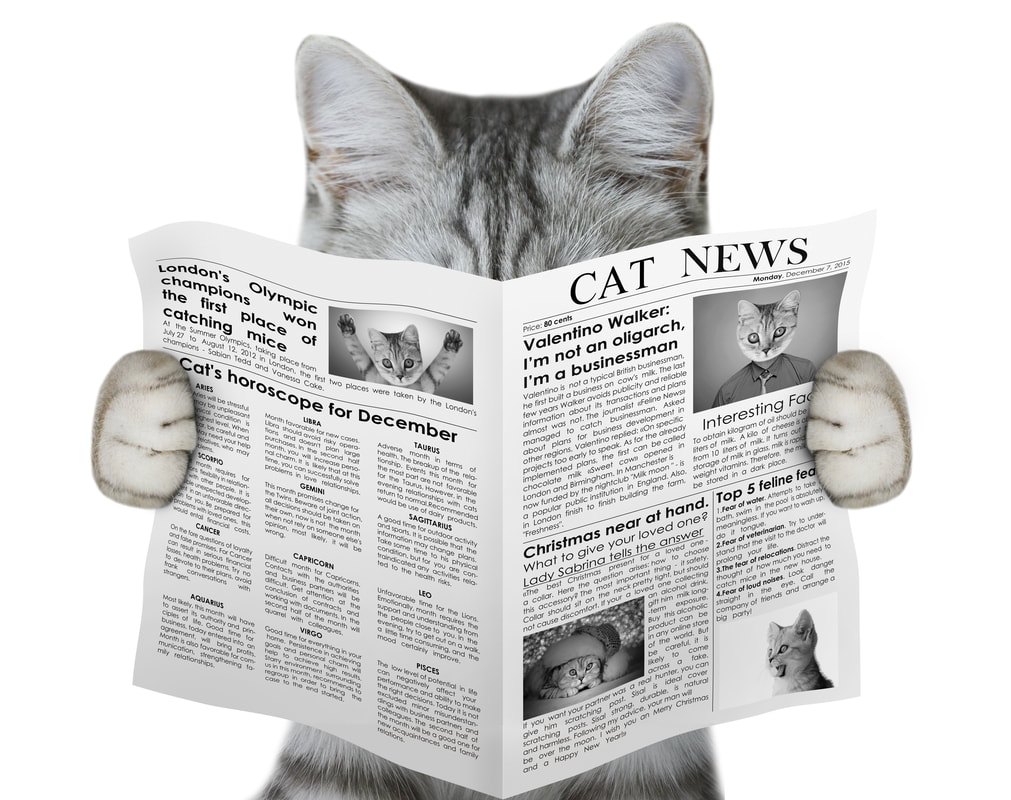








 RSS Feed
RSS Feed































